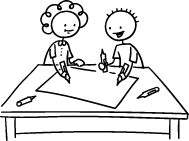Tips for things to do during the worksheet section of our lessons
There are so many things we can do to help our students during the worksheet practice section of the lesson. The teacher is there to help, motivate and inspire and at the same time your students can help each other out and do extra activities to improve their learning and retention. This is a great component of the lesson, if done right!
Here are 10 fantastic things for you to do and encourage your students to do during worksheet time.

1. Model the worksheet task
Always start by holding up the worksheet to the class, explaining what to do, and then showing how you would do the worksheet. Do all this before handing out the worksheets to ensure you have everyone’s full attention. By modelling what to do, there shouldn’t be any confusion once the worksheets are given out and the activity begins. You don’t need to go through and complete the whole worksheet in front of everyone, just do enough so it is clear what to do.
 2. Circulate and monitor
2. Circulate and monitor
The teacher should never treat worksheet time as their own personal time out. This is a time to work one-on-one with students – move from student-to-student and see exactly what they are doing. You can quickly see who is struggling and needs help, as well also motivate and encourage.
3. Praise, praise, praise
Students react well to praise – who doesn’t? As you circulate, point out certain aspects on each student’s worksheet and praise them on work done well. Use different phrases as you do so:
- Good / Great job!
- I really like that!
- That’s wonderful / fantastic / amazing
- That’s beautiful!
- Keep up the good work!
- etc.
You can also draw happy faces on their worksheets or even award stickers.
4. Ask questions
Don’t just look at the worksheets and move on – get involved with what each student is doing by having a conversation about their work.
- Ask what colors they have used in pictures
- Point to specific images and ask what they are or what the people are doing
- Ask why they have chosen certain answers
- Ask for extra information based on their answers
All of this really helps the teacher check the student’s understanding of the subject and encourages communication.
5. Encourage students to vocalize what they are writing
By having students read aloud what they are writing really helps with pronunciation and internalization. For example, as students write out the alphabet, get them to say each letter as they write it down. Have them also do this for words and sentences. The teacher can then quickly help with any pronunciation errors as well hear mistakes for quick correction.
 6. Encourage communication by pairing up students
6. Encourage communication by pairing up students
A great way to get students talking is by having them do a worksheet together. Put students in pairs and give them one worksheet to complete together. Make sure everyone uses English and check that no one is dominating the worksheet task.
7. Teacher’s helpers
For any students who finish their worksheets early, have them take on the role of teacher’s helper – they can also circulate around the classroom, helping students with any problems they are having.
8. Play English songs
As students are working on their exercises, play a CD of kids English songs – songs they have sung in class or will do in the future. Kids enjoy singing along as they do their work.
 9. Review past worksheets
9. Review past worksheets
If you keep everyone’s worksheets in a folder, you can whip out past worksheets and test students on them – this is especially helpful for students who finish their worksheets early!
10. Show and tell
When everyone has finished their worksheets, have students take turns in standing up and showing their work to the class. Ask each student a question based on their worksheet and give lots of praise! Finally, have everyone put their worksheets, pens and other stationery items away before going onto the next section of the lesson.


